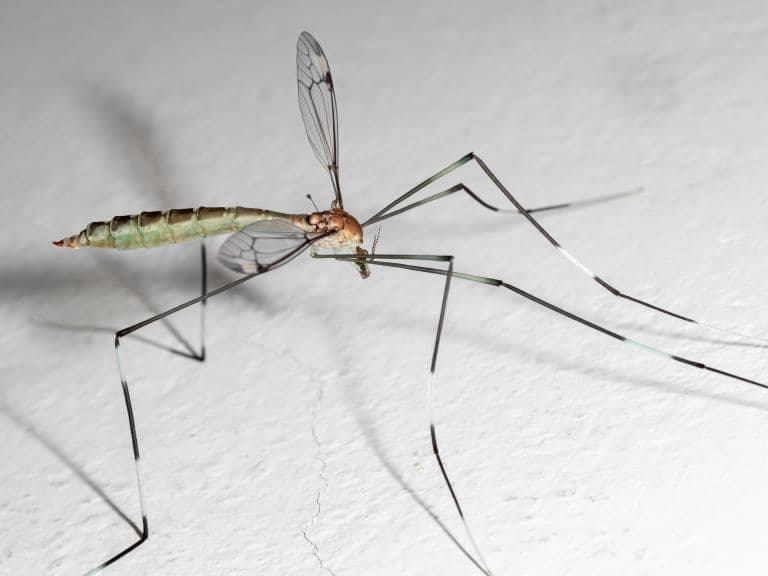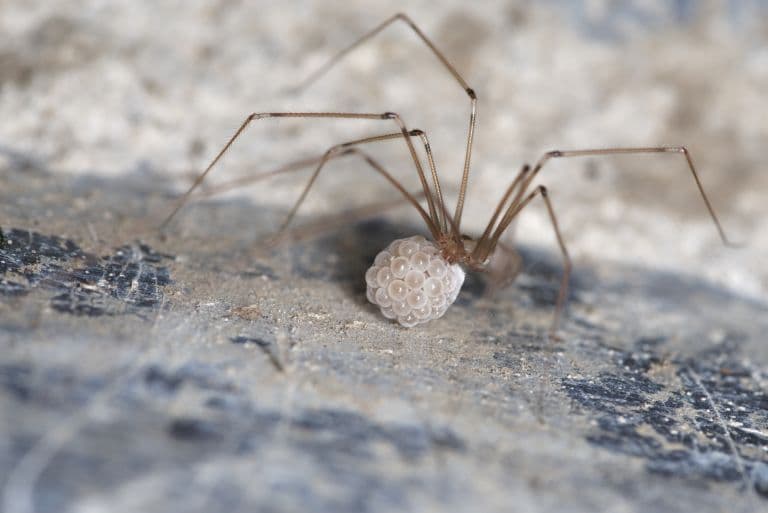Daddy Long Legs (Pholcidae) Profile
Neurologists are starting to suggest that it’s the communication between the almond-shaped amygdala and the prefrontal cortex in the brain that determines how well the human mind processes risk. Essentially, the amygdala pre-determines danger and feeds this message to the PFC, which can then decide what to do with it.
But the size of the amygdala plays a role, too. Spiders are notoriously creepy as a group, and there’s a strong suggestion that people with the highest fear of spiders have smaller left amygdala sizes.
But from the most infamous order of arthropods, the cellar spider, or, Daddy Long Legs spider, seems to elicit some of the lowest reactions of fear and disgust, even in those with lacklustre amygdala, and despite being rumoured as having the most potent venom of all.
But this is baffling on both counts, because they are both creepy as all hell and totally harmless.

Daddy Long Legs (Pholcidae) Facts Overview
| Habitat: | Low light, sheltered areas |
| Location: | Worldwide outside of the polar regions |
| Lifespan: | 3 years |
| Size: | Up to 1cm body length, with a leg span of up to 10 cm (4 in) |
| Weight: | Very light |
| Colour: | Usually grey or yellow-brown |
| Diet: | Spiders, insects |
| Predators: | Birds, lizards, insects |
| Top Speed: | Mostly sedentary or slow-moving |
| No. of Species: | Approx. 1,800 species in 70 genera |
| Conservation Status: | Least concern |
The Daddy Long Legs is a spider with many names. And many strange rumours around the danger it’s packing. Up close, it’s certainly one of the ugliest spiders and its bulging eye stalk and ridiculously long legs don’t do it any favours.
But from a distance, it has the density of a cat fart and despite all its weird vibrating can easily go unnoticed, sitting in the corner of the room, waiting to climb up your sleeping nostrils or feed on any species of spider unlucky enough to come too close.
This is an often-overlooked species of spider with a high creep-factor to anyone paying close enough attention. But while venomous – like all spiders are – rumours of its potency are overblown.
Interesting Daddy Long Legs (Pholcidae) Facts
1. “Daddy Longlegs”
The phrase “Daddy Longlegs” has been around for at least a century, being the name of an American novel from 1912, about an orphan and a shadowy (and shady) benefactor and nothing to do with spiders.
But depending on where you come from it can refer to a number of different animals. One attribution of the phrase goes to the crane flies, those ethereal, gangly Dipterans from the Triassic period that are now known to bumble about across lawns and produce leathery, wriggling pupas.
Another goes to the harvestmen, an order of spider-like arachnids that are somehow even more ancient and eerie than spiders but get none of the flak.
Finally, the cellar spiders: as leggy and lightweight as the previous two but less mobile, and the only spider commonly given the name.
These are the Pholcids, a family of bulbous, lanky spiders with a strange reputation. These are the subject of this particular piece, but the other two examples are equally valid.
They are often measured by their body size, which ranges from just over one millimetre to around 10 to 11 mm. This doesn’t sound like much, but the brain-shaped abdomen, the bulging eye stalks and the fact that all of this alien matter is supported on legs thinner than a human hair and around 5cm across, make them particularly unsettling when seen up close.
This creepiness, however, doesn’t appear to have been fully noticed by the wider population.

2. They’re not very scary
Possibly the most fun branch of psychology to study is whatever the branch is responsible for showing people scary pictures of spiders and ranking their responses. This is the kind of psychology that reads more like a scientifically justified TikTok video and would be a far less brain-rotting use of the platform if it was.
A group of (hopefully) volunteers were presented with a series of spider images, along with other creatures that might loosely resemble spiders (ex. the aforementioned harvestmen) and their self-reported fear and disgust factors were recorded.
These results allowed the researchers to identify the scariest spiders and the strongest consensus (determined by the standard deviation (SD), or the range of people who agreed).
The iconic Latrodectus mactans, or “black widow” scored the highest, which isn’t all that surprising, followed by the stocky and muscular trapdoor spider, Aptostichus miwok. All good choices, and the SD suggests a strong consensus there.
The trapdoor spider also scored the highest in disgust, and also with a strong consensus.
But the daddy long legs species, Pholcus phalangioides, ranked very low, sitting just above a millipede, which is essentially the cow of the arthropod world.
So, the popular image, at least among the Eastern Europeans tested, is that these spiders aren’t all that. And that’s strange, really. Considering how these spiders love to hang upside down in the corner of the ceiling, watching, waiting. 1
3. Their webs aren’t sticky
Many spiders use sticky silk to snare their victims. Daddy long legs don’t.
Instead, they’re far more active in their attacks, lunging towards anything that finds itself tapping on the web and enveloping it in silk.
They’ll either store it or eat it later, but even being far smaller than most, they’re able to take on full-sized house spiders.

4. They eat other spiders
Pholcids are known spider hunters (and if this doesn’t automatically make them scarier than the leggy little derps you find in your bathtub, we have more to come).
They’ll take on much larger spiders who are unlucky enough to get too close, but some species will even invade the webs of other species, raiding their eggs, or even mimicking prey by vibrating the host’s web and getting it all excited for mealtime.
When it comes out for lunch, it’s attacked, envenomated and eaten.
And remember that Laterodectus species that scored the highest in the creep factor? Redback spiders, from the same genus, are common victims. As are huntsman and house spiders.
When they’ve finished sucking their victim dry, they’ll cut the web and let the desiccated corpse fall disdainfully to the ground, or into your open mouth if you happen to be sleeping under one.
5. They can dance
These horror shows even move in a way that spiders have no business moving. When disturbed, they’ll vibrate, gyrating, sometimes in a circular pattern – often seen in common orb weavers like the garden spiders – and basically turn into a blur of legs and web.
This is unsettling, but it’s great at making them hard to pick out and therefore peck out, if the threat is coming from a bird who might otherwise eat them. It might also be used as a display of rage, if the threat is a potential rival.
If the vibrating doesn’t work, it can hop off the web and fall to the ground, scurrying into any clothes you might have left on the floor. 2
6. They carry their eggs in their mouths
The incredible and intelligent wolf spiders probably hold the title for creepiest maternal behaviours, as they can be seen crawling with spiderlings poking their limbs and faces out of their mother’s back and triggering all kinds of Trypophobes.
But a close second has to be the daddy long legs’ habit of wandering around with a sack of grey, alien eggs in her mouth, turning her outline from a creepy alien brain sac into a creepy alien brain sac with eggs.

7. They are venomous
One rumour about these spiders (and about the cranefly) is that these animals have the most potent venom known, but their mouths are incapable of injecting humans. Most crane flies have no mouth at all, so that part is true but the rest is entirely false.
All spiders are venomous, including cellar spiders (crane flies aren’t), and some species can bite humans. They have a similar fang structure to the brown recluse, but bites are indeed rare, and from the scant evidence, they appear to be nothingburgers.
There’s no evidence that any Pholcid species has ever caused harm to a person. This might have more to do with their ability to hide the evidence than their inherent lack of tools, but either way, the myth is baseless.
Daddy Long Legs (Pholcidae) Fact-File Summary
Scientific Classification
| Kingdom: | Animalia |
| Phylum: | Arthropoda |
| Class: | Arachnida |
| Order: | Araneae |
| Family: | Pholcidae |
Fact Sources & References
- Eva Landová (2021), “Specificity of spiders among fear- and disgust-eliciting arthropods: Spiders are special, but phobics not so much”, NIH.
- “Vibrating Spiders – Family Pholcidae”, North American Insects & Spiders.
